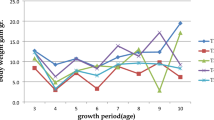Abstract
Protein digestibility (in vitro) of grains of chickpea (Cicer arietinum) and blackgram (Vigna mungo) cultivars varied from 48 to 53% and 52 to 58%, respectively. Soaking, cooking (both of unsoaked and soaked seeds), autoclaving and sprouting improved significantly the protein digestibility of all the cultivars of chickpea and blackgram. Autoclaving was found to be most effective followed by cooking and sprouting; cooking of sprouts had only marginal effect. Protein digestibility was higher when soaked instead of unsoaked grains were cooked.
Similar content being viewed by others
References
Akeson WF, Stahman MA (1964) A pepsin-pancreatin digest index of protein quality evaluation. J Nutr 83:257–259
AOAC (1980) Official Methods of Analysis, 13th edn., Washington, DC: Association of Official Analytical Chemists
Boralkar M, Reddy NS (1985) Effect of roasting, germination and fermentation on the digestibility of starch and protein present in soybean. Nutr Rep Int 31:833–836
Buchanan RA (1969) In vivo and in vitro methods of measuring nutritional value of leaf protein preparation. Brit J Nutr 23:533–544
Bressani R, Elias LG (1979) The nutritional role of polyphenols in beans. In: Proc. Symp. Polyphenols in Cereals and Legumes. St. Louis, USA: Institute of Food Technologists
Elias LG, Fernadez DG, Bressani R (1979) Possible effects of seed coat polyphenols on the nutritional quality of bean products. J Food Sci 44:524–527
Hag N, Haard NF, Horse RE (1978) Influence of sprouting on the digestibility coefficient, trypsin inhibitor and globulin proteins of red kidney bean. J Food Sci 43:1874–1875
Hernadez M, Vega A, Sotelo A (1985) In vitro and in vivo protein digestibility determinations of raw and cooked cereals and legumes. Arch Latinoamer Nutr 34:513–516
Jood S, Chauhan BM, Kapoor AC (1987) Polyphenols of chickpea and blackgram as affected by domestic processing and cooking methods. J Sci Food Agric 39:145–150
Kadam SS, Ghorpade VM, Adsule RN, Salunkhe DK (1986) Trypsin inhibitor in moth bean; thermal stability and changes during germination and cooking. Plant Foods Hum Nutr 36:43–46
Khokhar S, Chauhan BM (1986) Antinutritional factors in moth bean (Vigna aconitifolia): varietal differences and effects of methods of domestic processing and cooking. J Food Sci 51:591–594
Khokhar S, Chauhan BM (1986) Effect of domestic processing and cooking on in vitro protein digestibility of Moth bean. J Food Sci 51:1083–1084
Liener IE (1976) Legume toxins in relation to protein digestibility — A review. J Food Sci 41:1076–1081
Ologhobo AD, Fetuga BL (1984) Distribution of phosphorus and phytate in some Nigerian varieties of legumes and some effects of processing. J Food Sci 49:199–201
Satwadhar PN, Kadam SS, Salunkhe DK (1981) Effect of germination and cooking on polyphenols and in vitro protein digestibility of horse gram and moth bean. Plant Foods Hum Nutr 31:71–76
Serraino MR, Thompson LU, Savoie L, Parent G (1985) Effect of phytic acid on the in vitro rate of digestibility of rape seeds protein and amino acids. J Food Sci 50:1689–1692
Singh U, Jambunathan R (1981) Studies on Desi and Kabuli chickpea (Cicer arietinum) cultivars; levels of protease inhibitor, level of polyphenolic compounds and in vitro protein digestibility. J Food Sci 46:1364–1367
Snedecor GW, Cochran WG (1967) Statistical Methods. New Delhi: Oxford and IBH Publishing Co.
Subbulakshmi G, Kumar KG, Venkataraman LV (1976) Effect of germination on the carbohydrates, proteins, trypsin inhibitor, amylase inhibitor and haemagglutinin in horsegram and Moth bean. Nutr Rep Int 13:19–31
Tan N, Wong K, Lumen BO (1984) Relationship of tannin levels and trypsin inhibitor activity of raw and heat treated winged bean. J Agric Food Chem 32:819–821
Udayasekhara RP, Deosthale YG (1982) Tannin content of pulses; varietal differences and effects of germination and cooking. J Sci Food Agric 33:1013–1016
Walker AF, Kochar N (1982) Effect of processing including domestic cooking on nutritional quality of legumes. Proc Nutr Soc 41:41–51
Author information
Authors and Affiliations
Rights and permissions
About this article
Cite this article
Jood, S., Chauhan, B.M. & Kapoor, A.C. Protein digestibility (in vitro) of chickpea and blackgram seeds as affected by domestic processing and cooking. Plant Food Hum Nutr 39, 149–154 (1989). https://doi.org/10.1007/BF01091894
Issue Date:
DOI: https://doi.org/10.1007/BF01091894




